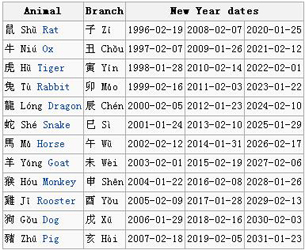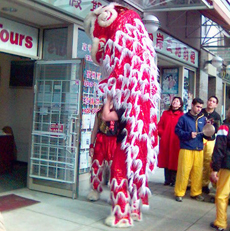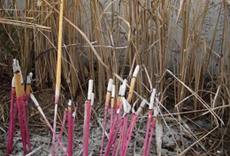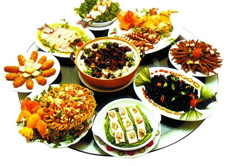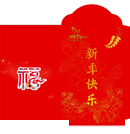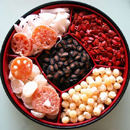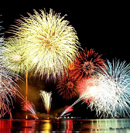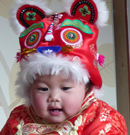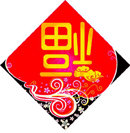| Chinese New Year is an important traditional Chinese holiday. In China, it is also known as the Spring Festival, the literal translation of the modern Chinese name. Chinese New Year celebrations traditionally ran from Chinese New Year's Eve, the last day of the last month of the Chinese calendar, to the Lantern Festival on the 15th day of the first month, making the festival the longest in the Chinese calendar. Because the Chinese calendar is lunisolar, the Chinese New Year is often referred to as the "Lunar New Year". View more… |
| Dates | |
| The lunisolar Chinese calendar determines the date of Chinese New Year. The calendar is also used in countries that have adopted or have been influenced by Han culture, notably the Koreans, Japanese and Vietnamese. In the Gregorian calendar, Chinese New Year falls on different dates each year, a date between January 21 and February 20. In the Chinese calendar, winter solstice must occur in the 11th month, which means that Chinese New Year usually falls on the second new moon after the winter solstice (rarely the third if an intercalary month intervenes). In traditional Chinese Culture, lichun is a solar term marking the start of spring, which occurs about February 4. | |
| Mythology According to tales and legends, the beginning of Chinese New Year started with the fight against a mythical beast called the Nian. Nian would come on the first day of New Year to eat livestock, crops, and even villagers, especially children. To protect themselves, the villagers would put food in front of their doors at the beginning of every year. It was believed that after the Nian ate the food they prepared, it wouldn’t attack any more people. One time, people saw that the Nian was scared away by a little child wearing red. The villagers then understood that the Nian was afraid of the color red. Hence, every time when the New Year was about to come, the villagers would hang red lanterns and red spring scrolls on windows and doors. People also used firecrackers to frighten away the Nian. From then on, Nian never came to the village again. The Nian was eventually captured by Hongjun Laozu, an ancient Taoist monk. The Nian became Hongjun Laozu's mount. |
| Festivities Preceding days On the eighth day of the lunar month prior to Chinese New Year, a traditional porridge known as làbāzhōu is served in remembrance "of an ancient festival, called Là, that occurred shortly after the winter solstice"… First day The first day is for the welcoming of the deities of the heavens and earth, officially beginning at midnight. It is a traditional practice to light… Third day The third day is known as Chìkǒu , directly translated as "red mouth". Chìkǒu is also called Chìgǒurì, or "Chìgǒu's Day". Chìgǒu, literally "red dog", is an epithet of "the God of Blazing Wrath"… Fourth day In those communities that celebrate Chinese New Year for only two or three days, the fourth day is when corporate "spring dinners" kick off and business returns to normal. Fifth day This day is the God of Wealth's birthday. In northern China, people eat jiǎozi (simplified Chinese:, or dumplings, on the morning of pòwǔ… | |
| |
| | Cuisine A reunion dinner is held on New Year's Eve during which family members gather for celebration. The venue will usually be in or near the home of the most senior member of the family. The New Year's Eve dinner is very large and sumptuous and traditionally includes dishes of meat (namely, pork and chicken) and fish. Most reunion dinners also feature a communal hot pot as it is believed to signify the coming together of the family members for the meal. Most reunion dinners (particularly in the Southern regions) also… View more… |
Practices
| | | | | |
See more:

